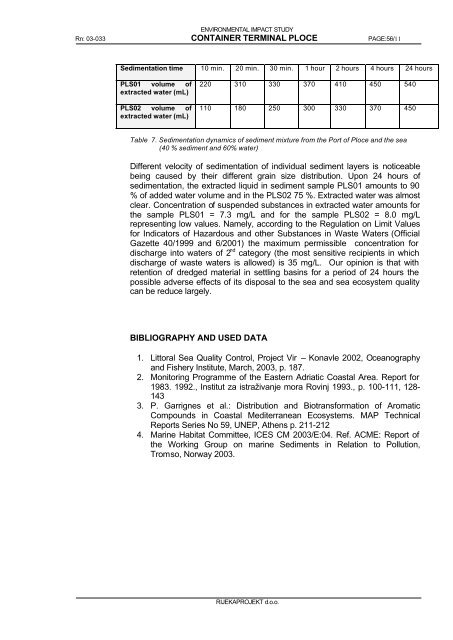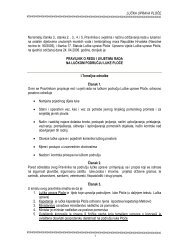HEADING PAGE - port of ploce authority * welcome
HEADING PAGE - port of ploce authority * welcome
HEADING PAGE - port of ploce authority * welcome
You also want an ePaper? Increase the reach of your titles
YUMPU automatically turns print PDFs into web optimized ePapers that Google loves.
ENVIRONMENTAL IMPACT STUDY<br />
Rn: 03-033 CONTAINER TERMINAL PLOCE <strong>PAGE</strong>:56/11<br />
Sedimentation time<br />
PLS01 volume <strong>of</strong><br />
extracted water (mL)<br />
PLS02 volume <strong>of</strong><br />
extracted water (mL)<br />
10 min. 20 min. 30 min. 1 hour 2 hours 4 hours 24 hours<br />
220 310 330 370 410 450 540<br />
110 180 250 300 330 370 450<br />
Table 7. Sedimentation dynamics <strong>of</strong> sediment mixture from the Port <strong>of</strong> Ploce and the sea<br />
(40 % sediment and 60% water)<br />
Different velocity <strong>of</strong> sedimentation <strong>of</strong> individual sediment layers is noticeable<br />
being caused by their different grain size distribution. Upon 24 hours <strong>of</strong><br />
sedimentation, the extracted liquid in sediment sample PLS01 amounts to 90<br />
% <strong>of</strong> added water volume and in the PLS02 75 %. Extracted water was almost<br />
clear. Concentration <strong>of</strong> suspended substances in extracted water amounts for<br />
the sample PLS01 = 7.3 mg/L and for the sample PLS02 = 8.0 mg/L<br />
representing low values. Namely, according to the Regulation on Limit Values<br />
for Indicators <strong>of</strong> Hazardous and other Substances in Waste Waters (Official<br />
Gazette 40/1999 and 6/2001) the maximum permissible concentration for<br />
discharge into waters <strong>of</strong> 2 nd category (the most sensitive recipients in which<br />
discharge <strong>of</strong> waste waters is allowed) is 35 mg/L. Our opinion is that with<br />
retention <strong>of</strong> dredged material in settling basins for a period <strong>of</strong> 24 hours the<br />
possible adverse effects <strong>of</strong> its disposal to the sea and sea ecosystem quality<br />
can be reduce largely.<br />
BIBLIOGRAPHY AND USED DATA<br />
1. Littoral Sea Quality Control, Project Vir – Konavle 2002, Oceanography<br />
and Fishery Institute, March, 2003, p. 187.<br />
2. Monitoring Programme <strong>of</strong> the Eastern Adriatic Coastal Area. Re<strong>port</strong> for<br />
1983. 1992., Institut za istraživanje mora Rovinj 1993., p. 100-111, 128-<br />
143<br />
3. P. Garrignes et al.: Distribution and Biotransformation <strong>of</strong> Aromatic<br />
Compounds in Coastal Mediterranean Ecosystems. MAP Technical<br />
Re<strong>port</strong>s Series No 59, UNEP, Athens p. 211-212<br />
4. Marine Habitat Committee, ICES CM 2003/E:04. Ref. ACME: Re<strong>port</strong> <strong>of</strong><br />
the Working Group on marine Sediments in Relation to Pollution,<br />
Tromso, Norway 2003.<br />
RIJEKAPROJEKT d.o.o.



